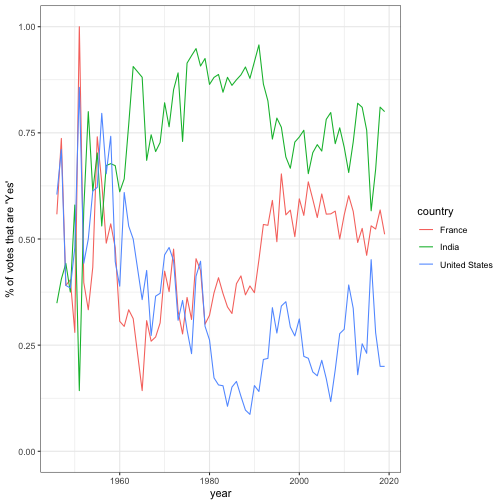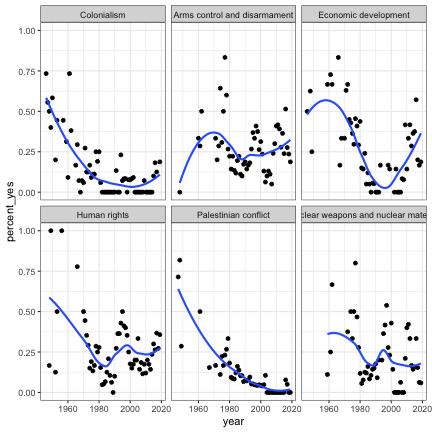The hardware and bandwidth for this mirror is donated by dogado GmbH, the Webhosting and Full Service-Cloud Provider. Check out our Wordpress Tutorial.
If you wish to report a bug, or if you are interested in having us mirror your free-software or open-source project, please feel free to contact us at mirror[@]dogado.de.
This package provides the voting history of countries in the United Nations General Assembly, along with information such as date, description, and topics for each vote.
These come from the dataset found here:
Erik Voeten “Data and Analyses of Voting in the UN General Assembly” Routledge Handbook of International Organization, edited by Bob Reinalda (published May 27, 2013)
This raw data, and the processing script, can be found in the data-raw folder.
Install the package with:
install.packages("unvotes")You can also install the development version of the package using devtools:
devtools::install_github("dgrtwo/unvotes")The package contains three datasets. First is the history of each
country’s vote. These are represented in the un_votes
dataset, with one row for each country/vote pair:
library(dplyr)
library(unvotes)
un_votes
#> # A tibble: 869,937 x 4
#> rcid country country_code vote
#> <dbl> <chr> <chr> <fct>
#> 1 3 United States US yes
#> 2 3 Canada CA no
#> 3 3 Cuba CU yes
#> 4 3 Haiti HT yes
#> 5 3 Dominican Republic DO yes
#> 6 3 Mexico MX yes
#> 7 3 Guatemala GT yes
#> 8 3 Honduras HN yes
#> 9 3 El Salvador SV yes
#> 10 3 Nicaragua NI yes
#> # … with 869,927 more rowsThe package also contains a dataset of information about each roll call vote, including the date, description, and relevant resolution that was voted on:
un_roll_calls
#> # A tibble: 6,202 x 9
#> rcid session importantvote date unres amend para short descr
#> <int> <dbl> <int> <date> <chr> <int> <int> <chr> <chr>
#> 1 3 1 0 1946-01-01 R/1/66 1 0 AMENDMENTS, RULE… "TO ADOPT A CUBAN AMENDMENT TO THE UK PROPOSAL REFERRI…
#> 2 4 1 0 1946-01-02 R/1/79 0 0 SECURITY COUNCIL… "TO ADOPT A USSR PROPOSAL ADJOURNING DEBATE ON AND POS…
#> 3 5 1 0 1946-01-04 R/1/98 0 0 VOTING PROCEDURE "TO ADOPT THE KOREAN PROPOSAL THAT INVALID BALLOTS BE …
#> 4 6 1 0 1946-01-04 R/1/1… 0 0 DECLARATION OF H… "TO ADOPT A CUBAN PROPOSAL (A/3-C) THAT AN ITEM ON A D…
#> 5 7 1 0 1946-01-02 R/1/2… 1 0 GENERAL ASSEMBLY… "TO ADOPT A 6TH COMMITTEE AMENDMENT (A/14) TO THE PROV…
#> 6 8 1 0 1946-01-05 R/1/2… 1 0 ECOSOC POWERS "TO ADOPT A SECOND 6TH COMM. AMENDMENT (A/14) TO THE P…
#> 7 9 1 0 1946-02-05 R/1/3… 0 0 POST-WAR RECONST… "TO OPEN THE DISCUSSION ON THE POLISH DRAFT RESOLUTION…
#> 8 10 1 0 1946-02-05 R/1/3… 1 1 U.N. MEMBERS, RE… "TO ADOPT GENERAL COMM. DRAFT RESOLUTION (A/40) AS AME…
#> 9 11 1 0 1946-02-05 R/1/3… 0 0 TRUSTEESHIP AMEN… "TO ADOPT DRAFT RESOLUTIONS I AND II AS A WHOLE, OF TH…
#> 10 12 1 0 1946-02-06 R/1/3… 1 1 COUNCIL MEMBER T… "TO ADOPT PARAGRAPH (A) OF THE 6TH COMM. DRAFT RESOLUT…
#> # … with 6,192 more rowsFinally, the un_roll_call_issues dataset shows
relationships between each vote and 6 issues:
un_roll_call_issues
#> # A tibble: 5,745 x 3
#> rcid short_name issue
#> <int> <chr> <fct>
#> 1 77 me Palestinian conflict
#> 2 9001 me Palestinian conflict
#> 3 9002 me Palestinian conflict
#> 4 9003 me Palestinian conflict
#> 5 9004 me Palestinian conflict
#> 6 9005 me Palestinian conflict
#> 7 9006 me Palestinian conflict
#> 8 128 me Palestinian conflict
#> 9 129 me Palestinian conflict
#> 10 130 me Palestinian conflict
#> # … with 5,735 more rows
count(un_roll_call_issues, issue, sort = TRUE)
#> # A tibble: 6 x 2
#> issue n
#> <fct> <int>
#> 1 Arms control and disarmament 1092
#> 2 Palestinian conflict 1061
#> 3 Human rights 1015
#> 4 Colonialism 957
#> 5 Nuclear weapons and nuclear material 855
#> 6 Economic development 765(Use help() to get information and documentation about
each dataset).
Many useful analyses will first involve joining the vote and roll
call datasets by the shared rcid (roll call ID) column:
library(dplyr)
joined <- un_votes %>%
inner_join(un_roll_calls, by = "rcid")
joined
#> # A tibble: 869,937 x 12
#> rcid country country_code vote session importantvote date unres amend para short descr
#> <dbl> <chr> <chr> <fct> <dbl> <int> <date> <chr> <int> <int> <chr> <chr>
#> 1 3 United St… US yes 1 0 1946-01-01 R/1/66 1 0 AMENDMENT… TO ADOPT A CUBAN AMENDMENT TO T…
#> 2 3 Canada CA no 1 0 1946-01-01 R/1/66 1 0 AMENDMENT… TO ADOPT A CUBAN AMENDMENT TO T…
#> 3 3 Cuba CU yes 1 0 1946-01-01 R/1/66 1 0 AMENDMENT… TO ADOPT A CUBAN AMENDMENT TO T…
#> 4 3 Haiti HT yes 1 0 1946-01-01 R/1/66 1 0 AMENDMENT… TO ADOPT A CUBAN AMENDMENT TO T…
#> 5 3 Dominican… DO yes 1 0 1946-01-01 R/1/66 1 0 AMENDMENT… TO ADOPT A CUBAN AMENDMENT TO T…
#> 6 3 Mexico MX yes 1 0 1946-01-01 R/1/66 1 0 AMENDMENT… TO ADOPT A CUBAN AMENDMENT TO T…
#> 7 3 Guatemala GT yes 1 0 1946-01-01 R/1/66 1 0 AMENDMENT… TO ADOPT A CUBAN AMENDMENT TO T…
#> 8 3 Honduras HN yes 1 0 1946-01-01 R/1/66 1 0 AMENDMENT… TO ADOPT A CUBAN AMENDMENT TO T…
#> 9 3 El Salvad… SV yes 1 0 1946-01-01 R/1/66 1 0 AMENDMENT… TO ADOPT A CUBAN AMENDMENT TO T…
#> 10 3 Nicaragua NI yes 1 0 1946-01-01 R/1/66 1 0 AMENDMENT… TO ADOPT A CUBAN AMENDMENT TO T…
#> # … with 869,927 more rowsOne could then count how often each country votes “yes” on a resolution in each year:
library(lubridate)
by_country_year <- joined %>%
group_by(year = year(date), country) %>%
summarize(votes = n(),
percent_yes = mean(vote == "yes"))
by_country_year
#> # A tibble: 10,461 x 4
#> # Groups: year [73]
#> year country votes percent_yes
#> <dbl> <chr> <int> <dbl>
#> 1 1946 Afghanistan 17 0.412
#> 2 1946 Argentina 43 0.698
#> 3 1946 Australia 43 0.558
#> 4 1946 Belarus 43 0.442
#> 5 1946 Belgium 43 0.605
#> 6 1946 Bolivia 43 0.698
#> 7 1946 Brazil 43 0.605
#> 8 1946 Canada 42 0.643
#> 9 1946 Chile 43 0.605
#> 10 1946 Colombia 42 0.310
#> # … with 10,451 more rowsAfter which this can be visualized for one or more countries:
library(ggplot2)
theme_set(theme_bw())
countries <- c("United States", "India", "France")
by_country_year %>%
filter(country %in% countries) %>%
ggplot(aes(year, percent_yes, color = country)) +
geom_line() +
ylab("% of votes that are 'Yes'") +
expand_limits(y = 0)
Similarly, we could look at how the voting record of the United
States has changed on each of the issues by joining with the
un_roll_call_issues dataset:
joined %>%
filter(country == "United States") %>%
inner_join(un_roll_call_issues, by = "rcid") %>%
group_by(year = year(date), issue) %>%
summarize(votes = n(),
percent_yes = mean(vote == "yes")) %>%
filter(votes > 5) %>%
ggplot(aes(year, percent_yes)) +
geom_point() +
geom_smooth(se = FALSE) +
facet_wrap(~ issue)
Please note that this project is released with a Contributor Code of Conduct. By participating in this project you agree to abide by its terms.
These binaries (installable software) and packages are in development.
They may not be fully stable and should be used with caution. We make no claims about them.
Health stats visible at Monitor.